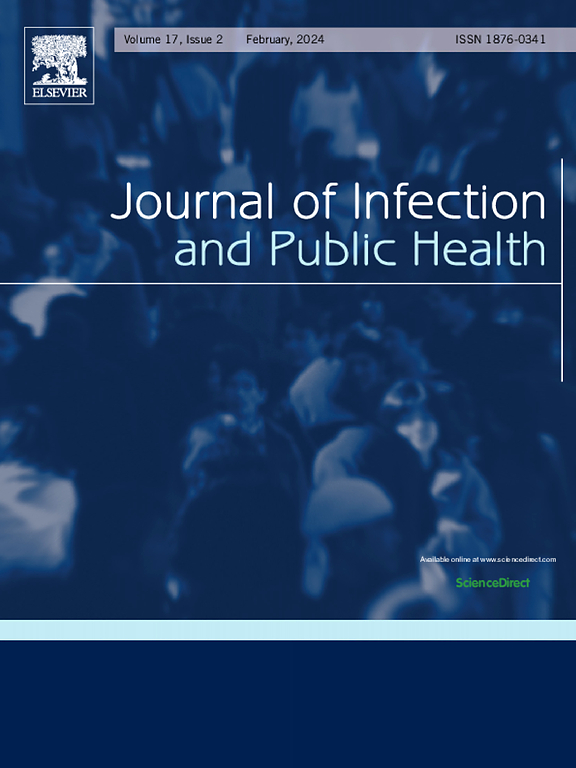台湾地区脓肿分枝杆菌肺部疾病病原菌基因型与宿主表型
IF 4
3区 医学
Q1 INFECTIOUS DISEASES
引用次数: 0
摘要
脓肿分枝杆菌(Mabs)肺部疾病(Mabs- pd)很难治疗,特别是在脓肿分枝杆菌亚种(Mabs-a)中,与马氏杆菌亚种(Mabs-m)不同,它通常含有大环内酯耐药的后遗症。mab基因变异与临床特征之间的关系在很大程度上仍未被探索。方法在这项回顾性队列研究中,观察2016-2018年期间发现的单克隆抗体- pd和单克隆抗体肺外疾病(Mabs- ed)患者的严重或进行性单克隆抗体- pd,其表现为抗生素需求或肺部病变增加。对单克隆抗体分离株的DNA进行测序,以确定亚种并评估大环内酯耐药遗传变异(rrl突变或T28序列的功能性erm(41))。结果Mabs-PD组(n = 77)比Mabs-ED组(n = 20)更老、更瘦。在单抗- pd中,84.6 %的单抗-a (n = 42)和9.4 %的单抗-m (n = 35)分离株(p <; 0.001)检测到大环内酯类耐药遗传变异。空洞的疾病(n = 10)和non-cavitary双边疾病(n = 45)与风险增加有关的严重或进步Mabs-PD相比non-cavitary单边疾病(n = 22)(调整后的优势比为13.039(95 %可信区间1.239 - -137.172),p = 0.032;和4.875 [0.755-31.502],p = 0.096)。与非空洞性单侧疾病患者相比,患有空洞性疾病或非空洞性双侧疾病的患者更容易携带mab -m分离株(50.0 %和57.8 %对18.2 %,p = 0.008)。双侧疾病(n = 54,包括9个腔疾病)与大环内酯类药物耐药基因变异呈负相关,这一发现在亚组分析中一致,校正优势比为0.187(95 % CI [0.054-0.646], p = 0.008)。结论伴有空洞或双侧疾病的单克隆抗体- pd患者,可能需要开始治疗,携带大环内酯耐药单克隆抗体的风险较低,强调了表型特异性调查对加强临床决策的重要性。本文章由计算机程序翻译,如有差异,请以英文原文为准。
Pathogen genotypes and host phenotypes of Mycobacterium abscessus pulmonary disease in Taiwan
Background
Mycobacterium abscessus (Mabs) pulmonary disease (Mabs-PD) is difficult to treat, particularly in subspecies abscessus (Mabs-a), usually harboring macrolide-resistant sequevars, unlike subspecies massiliense (Mabs-m). The relationship between Mabs genetic variants and clinical features remains largely unexplored.
Methods
In this retrospective cohort study, patients with Mabs-PD and Mabs extrapulmonary disease (Mabs-ED), identified during 2016–2018, were observed for severe or progressive Mabs-PD, indicated by antibiotic needs or increased lung lesions. DNA of Mabs isolates was sequenced to determine subspecies and evaluate macrolide-resistance genetic variants (rrl mutations or functional erm(41) with T28 sequevar).
Results
The Mabs-PD group (n = 77) was older and thinner than the Mabs-ED group (n = 20). In Mabs-PD, macrolide-resistance genetic variants were detected in 84.6 % of Mabs-a (n = 42) and 9.4 % of Mabs-m (n = 35) isolates (p < 0.001). Cavitary disease (n = 10) and non-cavitary bilateral disease (n = 45) were associated with an increased risk of severe or progressive Mabs-PD compared to non-cavitary unilateral disease (n = 22) (adjusted odds ratio 13.039 [95 % CI 1.239–137.172], p = 0.032; and 4.875 [0.755–31.502], p = 0.096, respectively). Patients with cavitary disease or non-cavitary bilateral disease were more likely to harbor Mabs-m isolates compared to those with non-cavitary unilateral disease (50.0 % and 57.8 % vs. 18.2 %, p = 0.008). Bilateral disease (n = 54, with 9 cavitary disease included) was inversely associated with macrolide-resistance genetic variants, a finding consistent across subgroup analyses, with an adjusted odds ratio of 0.187 (95 % CI [0.054–0.646], p = 0.008).
Conclusions
Mabs-PD patients with cavitary or bilateral disease, potentially requiring treatment initiation, had a lower risk of harboring macrolide-resistant Mabs, emphasizing the importance of phenotype-specific investigations to enhance clinical decision-making.
求助全文
通过发布文献求助,成功后即可免费获取论文全文。
去求助
来源期刊

Journal of Infection and Public Health
PUBLIC, ENVIRONMENTAL & OCCUPATIONAL HEALTH -INFECTIOUS DISEASES
CiteScore
13.10
自引率
1.50%
发文量
203
审稿时长
96 days
期刊介绍:
The Journal of Infection and Public Health, first official journal of the Saudi Arabian Ministry of National Guard Health Affairs, King Saud Bin Abdulaziz University for Health Sciences and the Saudi Association for Public Health, aims to be the foremost scientific, peer-reviewed journal encompassing infection prevention and control, microbiology, infectious diseases, public health and the application of healthcare epidemiology to the evaluation of health outcomes. The point of view of the journal is that infection and public health are closely intertwined and that advances in one area will have positive consequences on the other.
The journal will be useful to all health professionals who are partners in the management of patients with communicable diseases, keeping them up to date. The journal is proud to have an international and diverse editorial board that will assist and facilitate the publication of articles that reflect a global view on infection control and public health, as well as emphasizing our focus on supporting the needs of public health practitioners.
It is our aim to improve healthcare by reducing risk of infection and related adverse outcomes by critical review, selection, and dissemination of new and relevant information in the field of infection control, public health and infectious diseases in all healthcare settings and the community.
 求助内容:
求助内容: 应助结果提醒方式:
应助结果提醒方式:


